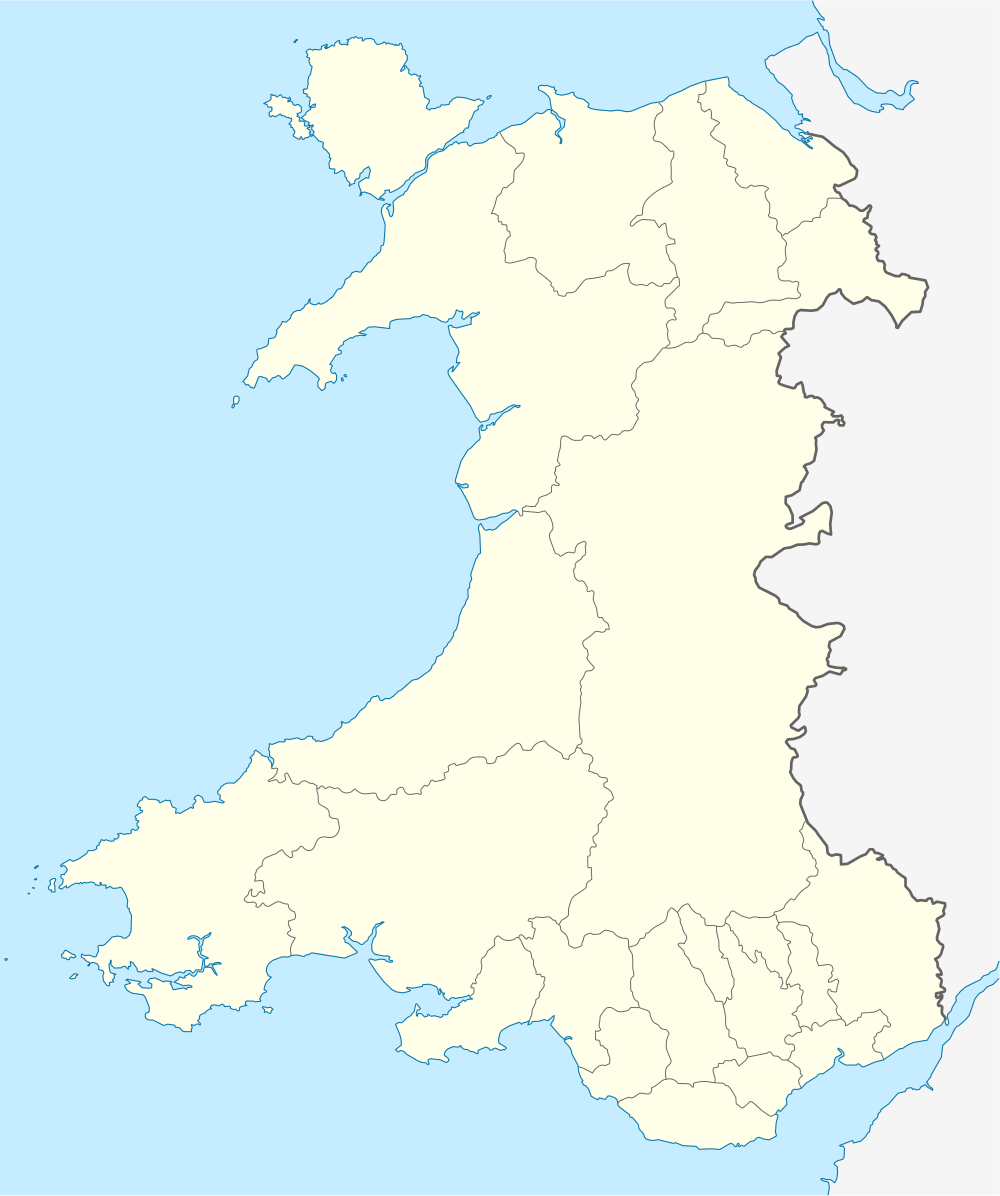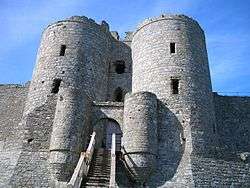Denbigh Castle
| Denbigh Castle | |
|---|---|
| Part of Denbighshire | |
| Denbigh, Wales | |
|
The remains of the three-towered main gateway. | |
 Denbigh Castle | |
| Coordinates | 53°10′50″N 3°25′15″W / 53.1806°N 3.4207°WCoordinates: 53°10′50″N 3°25′15″W / 53.1806°N 3.4207°W |
| Type | Enclosure castle with gateway donjon. |
| Height | Up to 10 metres (33 ft) |
| Site information | |
| Owner | Cadw |
| Controlled by | The Crown |
| Condition | Ruin |
| Site history | |
| Built |
First phase c.1282 Second phase c.1295 |
| Built by | Henry de Lacy, 3rd Earl of Lincoln |
| In use | Open to public |
| Materials | Limestone ashlar |
| Demolished | 1647 |
| Events |
Welsh Wars 1277 Madog ap Llywelyn 1294 Glyndŵr Rising 1404 Wars of the Roses 1461–1468 English Civil War 1646 |
Listed Building – Grade I | |
Denbigh Castle (Welsh: Castell Dinbych) was a fortress built following the 13th-century conquest of Wales by Edward I.
The castle, which stands on a rocky promontory above the Welsh market town of Denbigh, Denbighshire, was built upon an earlier Welsh stronghold. It was defended by a unique triple-towered gateway.
A planned town (bastide) was laid out at the same time as the castle. The Anglo-Norman borough was an attempt by Edward I to pacify the Welsh.
Construction
Denbigh Castle, which was built during two phases, was based on designs attributed to Master James of St George. In the first period, commencing 1282, parts of the outer ward were constructed. These outer defences included the southern and western walls and the eastern towers. Later work on the inner ward began including parts of the curtain wall and the castle's main gatehouse. The borough's new town walls were also began during this period.

But in 1294 Denbigh was attacked and taken during the revolt of Madog ap Llywelyn halting the work on the incomplete town and castle. Following its recapture a year later, Henry de Lacy substantially revised the plans in the second phase of building work. This time the inner ward's curtain wall were refortified with thicker and higher walls.
The main gatehouse was heavily buttressed with a three octagonal towers and a drawbridge: two towers faced outwards and a third interior tower, (the Badnes Tower), inside the main gateway. This three-towered triangular gatehouse now created a heavily defended passageway that had murder-holes, portcullises in series, two wooden doors, and enfilading arrowslits. One gatehouse tower contained the porter's lodgings while the other served as the prison.
During the same period, the Great hall and the eastern domestic ranges including the kitchen tower, the pantry and the postern gate were completed. When the town walls were enlarged, the eastern section was defended by several large D-shaped towers such as the Countess Tower and Goblin Tower.
De Lacy died in 1311 before building work ceased on the town and castle defences. The new English borough eventually removed all traces of the original Welsh fortifications.
History

The current Denbigh Castle was built on the site of a former Welsh stronghold held by Dafydd ap Gruffydd, the brother of Llywelyn ap Gruffudd. The Welsh castle originally belonged to Llywelyn the Great. In 1230, an Abbot from England visited Llywelyn the Great at his new castle in Denbigh.
The current stone castle was begun by Henry de Lacy, 3rd Earl of Lincoln in the Lordship of Denbigh given to him by Edward I after the defeat of the last Welsh prince, Dafydd ap Gruffudd in 1282. The Welsh castle was then torn down and work began on a new English fortress. At the same time, De Lacy was also granted a Royal Charter to create a new English borough and town.
But in 1294, the incomplete castle was besieged and captured by Welsh forces during the revolt of Madog ap Llywelyn. During the subsequent siege, an English force under de Lacy was defeated trying to retake the castle. However the revolt collapsed and Denbigh was returned to de Lacy a year later. Building work then resumed. Following some defensive improvements, the castle and walls were substantially complete by 1305.
In the 1290s, Edward I had issued a second Royal Charter as the market town of Denbigh had rapidly expanded beyond the town walls and its borough boundaries. By 1305 there were titled 183 settlers living outside the town walls and only 52 inside the town's defences. The castle and its precincts were being superseded by the area outside the walls which had developed into the town's market centre. A Carmelite Friary was also established in the town just outside the town walls.
In 1400, the forces of Owain Glyndŵr attacked Denbigh. The town was badly damaged but the castle resisted a siege and was not captured.

During the Wars of the Roses, Jasper Tudor, the Lancastrian Earl of Pembroke, tried twice and failed to take the castle in the 1460s.
In the 16th century Robert Dudley, Earl of Leicester, held Denbigh Castle and its Lordship between 1563 until his death in 1588.
During the English Civil War, the castle was repaired by Royalist Colonel William Salesbury of Rug. King Charles I of England stayed there briefly in September 1645. The following year, the castle endured a six-month siege before finally being forced to surrender to Parliamentarian forces. The castle was then slighted to prevent its further use. For the remainder of the war part of the castle was used as a prison for captured royalists.
Following the restoration of Charles II in 1660, the castle was abandoned and allowed to fall into decay.
Present day
The castle is managed by Cadw – the Welsh heritage agency tasked with looking after historic buildings and monuments in Wales.
See also
External links
| Wikimedia Commons has media related to Denbigh Castle. |
- Official Cadw site – Denbigh Castle
- Photos of Denbigh Castle at geograph.co.uk

